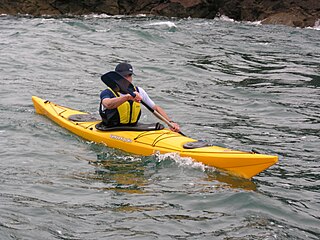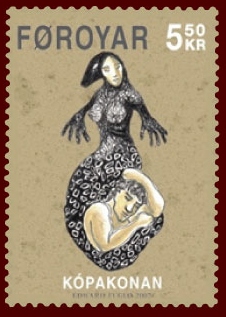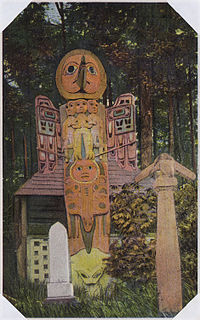Related Research Articles

A kayak is a small, narrow watercraft which is typically propelled by means of a double-bladed paddle. The word kayak originates from the Greenlandic word qajaq.

Inuit religion is the shared spiritual beliefs and practices of the Inuit, an indigenous people from Alaska, Canada, parts of Siberia and Greenland. Their religion shares many similarities with some Alaska Native religions. Traditional Inuit religious practices include animism and shamanism, in which spiritual healers mediate with spirits. Today many Inuit follow Christianity, but traditional Inuit spirituality continues as part of a living, oral tradition and part of contemporary Inuit society. Inuit who balance indigenous and Christian theology practice religious syncretism.

Sedna is the goddess of the sea and marine animals in Inuit mythology, also known as the Mother of the Sea or Mistress of the Sea. The story of Sedna, which is a creation myth, describes how she came to rule over Adlivun, the Inuit underworld.
The Adlet are a race of creatures in the Inuit mythology of Greenland, as well as the Labrador and Hudson Bay coasts. While the word refers to inland native American tribes, it also denotes a humanoid dog-legged tribe. The lower part of the body of the canine Adlet is like that of a dog and their upper part is like a man's. All Adlet run quickly, and their encounters with men usually end with man as the victor.

A sea kayak or touring kayak is a kayak developed for the sport of paddling on open waters of lakes, bays, and the ocean. Sea kayaks are seaworthy small boats with a covered deck and the ability to incorporate a spray deck. They trade off the manoeuvrability of whitewater kayaks for higher cruising speed, cargo capacity, ease of straight-line paddling, and comfort for long journeys.

In Celtic and Norse mythology, selkies or selkie folk meaning 'seal folk' are mythological beings capable of therianthropy, changing from seal to human form by shedding their skin. They are found in folktales and mythology originating from the Northern Isles of Scotland.

Jessie Oonark, was a prolific and influential Canadian Inuit artist of the Utkuhihalingmiut Utkuhiksalingmiut whose wall hangings, prints and drawings are in major collections including the National Gallery of Canada. She was born in 1906 in the Chantrey Inlet (Tariunnuaq) area, near the estuary of the Back River in the Keewatin District of the Northwest Territories —the traditional lands of the Utkukhalingmiut Utkukhalingmiut, Utkukhalingmiut. Her artwork portrays aspects of the traditional hunter-nomadic life that she lived for over five decades, moving from fishing the camp near the mouth of Back River on Chantrey Inlet in the Honoraru area to their caribou hunting camp in the Garry Lake area, living in winter snow houses (igloos) and caribou skin tents in the summer. Oonark learned early how to prepare skins and sew caribou skin clothing. They subsisted mainly on trout, whitefish, and barren-ground caribou. The knife used by women, the ulu, their traditional skin clothing, the kamik, the amauti were recurring themes in her work. Oonark has had a major museum retrospective with accompanying scholarly monograph. Despite a late start – she was 54 years old when her work was first published – she was a very active and prolific artist over the next 19 years, creating a body of work that won considerable critical acclaim and made her one of Canada's best known Inuit artists.

Raven Tales are the traditional human and animal creation stories of the indigenous peoples of the Pacific Northwest Coast. They are also found among Athabaskan-speaking peoples and others. Raven stories exist in nearly all of the First Nations throughout the region but are most prominent in the tales of the Tsimshian, Tlingit and Tahltan people.

Melanesian mythology is the folklore, myths and religion of Melanesia — the archipelagos of New Guinea, the Torres Strait Islands, the Admiralty Islands, Solomon Islands, New Caledonia and Vanuatu. Professor Roland Burrage Dixon wrote an account of the mythology of this region for The Mythology of All Races, which was published in 1916.

A kayak roll is the act of righting a capsized kayak by use of body motion and/or a paddle. Typically this is done by lifting the torso towards the surface, flicking the hips to right the kayak, and applying a small force by means of the paddle to assist the torso back over the boat.

Inuit are a group of culturally similar indigenous peoples inhabiting the Arctic and subarctic regions of Greenland, Canada, and Alaska. The Inuit languages are part of the Eskimo–Aleut languages also known as Inuit-Yupik-Unangan and also as Eskaleut. Inuit Sign Language is a critically endangered language isolate used in Nunavut.
Jens Christian Rosing was a notable Greenlandic artist, author and storyteller. He designed the coat of arms of Greenland, many Greenlandic postage stamps, as well as illustrated children's books and created diverse works of art.
Michael Arvaarluk Kusugak is a storyteller and a Canadian children's writer, who tells stories about Arctic and Inuit culture. He was born April 27, 1948 just north of Chesterfield Inlet, at a point of land we call Qatiktalik. That same spring of 1948 he and his family moved to Repulse Bay and in 1960 to Rankin Inlet. In 2019, he lives in Sooke, BC and plans to move to Manitoba in the summer.

Undone is the seventh in a series of collections of short stories by Australian author Paul Jennings. It was first released in 1993. First book in the series not to have any short stories be adapted into an episode of Round the Twist.
Utkuhiksalik, Utkuhikhalik, Utkuhikhaliq, Utkuhiksalingmiutitut, Utkuhiksalingmiutut, Utkuhiksalingmiut Inuktitut, Utku, Gjoa Haven dialect, is a sub-dialect of Natsilingmiutut (Nattiliŋmiut) dialect of Inuvialuktun language once spoken in the Utkuhiksalik area of Nunavut, and now spoken mainly by elders in Uqsuqtuuq and Qamani'tuaq on mainland Canada. It is generally written in Inuktitut syllabics.

The tupiq is a traditional Inuit tent made from seal or caribou skin. An Inuk was required to kill five to ten ugjuk to make a sealskin tent. When a man went hunting he would bring a small tent made out of five ugjuit. A family tent would be made of ten or more ugjuit.
Miriam Marealik Qiyuk is a Canadian Inuit artist.

Qaunaq Mikkigak was a Canadian artist and author. She was known primarily for sculpting but also created jewelry, story telling, drawing and did throat singing. As an artist she was interested in arts and crafts and built artistic works that were inspired by her imagination and emotions. She co-authored the children's books The Legend of the Fog and Grandmother Ptarmigan based on traditional Inuit stories. She was featured in the book Inuit women artists: voices from Cape Dorset for her artwork and in Cape Dorset Sculpture. She died in 2020.

The UtkuhiksalingmiutUkukhalingmiut, Utkukhalingmiut —the people of the place where there is soapstone—is one of 48 groups of Inuit in what is now Nunavut, Canada. Their traditional land was around Chantrey Inlet (Tariunnuaq) area, near the estuary of the Back River in, what was then called, the Keewatin District of the Northwest Territories. The Utkuhiksalingmiut followed the traditional hunter-nomadic life moving from fishing the camp near the mouth of the Back River on Chantrey Inlet to their caribou hunting camp in the Garry Lake area, living in winter snow houses (igloos) and caribou skin tents in the summer. They subsisted mainly on trout, whitefish, and barren-ground caribou.
The Goose Wife is a mythical female character that appears in tales from the Inuit and other ethnic groups that dwell across the circumpolar Arctic region. The usual story is that the geese alight on land, become women by taking off their goose-skins and bathe in a lake. However, they are unaware that a human hunter is spying on them, and he steals the goose-skin of one of them, forcing her to be his wife. Due to the great similarities between both characters, the goose wife has been compared to the swan maiden, another female that alternates between human and bird forms.
References
- ↑ Boas, Franz (March 1904), "The Folk-Lore of the Eskimo", The Journal of American Folklore, vol. 17, no. 64, pp. 1–13, retrieved 12 January 2014
- ↑ "Arvia'juaq and Qikiqtaarjuk National Historic Site of Canada". historicplaces.ca. Retrieved 2009-12-22.
- ↑ Mamnguqsualuk, Victoria (1986), "Keeveeok, Awake. Mamnguqsualuk and the Rebirth of Legend at Baker Lake", Boreal Institute for Northern Studies, University of Alberta, Edmonton, Alberta
- ↑ Jules Heller; Nancy G. Heller (19 December 2013). North American Women Artists of the Twentieth Century: A Biographical Dictionary. Routledge. ISBN 978-1-135-63882-5.
- 1 2 3 Fisher, Kyra Vkuiykov (Fall 2007), Mitchell, Marybelle (ed.), "Janet Kigusiuq Uqayuittuq" (PDF), Inuit Art Quarterly, Ottawa, Ontario, vol. 22 Number=3, p. 10, archived from the original (PDF) on 12 January 2015, retrieved 12 January 2014
- ↑ Jackson, Marion E.; Noah, William (April 1983), "Transcripts of interviews with Jessie Oonark and her Children", Inuit Art Section, DIAND, Baker Lake, no. NC 114 B32 o66 1984, p. 39
- ↑ Driscoll, Bernadette, Inuit Amautik